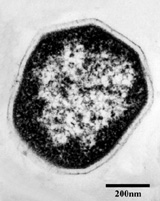Aeropyrum
A Microbial Biorealm page on the genus Aeropyrum

Classification
Higher order taxa:
Archaea; Crenarchaeota; Thermoprotei; Desulfurococcales; Desulfurococcaceae
Species:
Aeropyrum pernix, A. camini
Description and Significance
An Aeropyrum species has been located from a solfotaric vent at Kodakara-jima Island in Kyusyu, Japan. Aeropyrum is hyperthermophilic and shares many of the same attributes as Pyrococcus, except that it is an aerobic archaeon. Sequencing its genome is significant because it can provide answers on the origin of the oxygenic respiratory system. Research has demonstrated that the early branches of Archaea, about which relatively little is known in comparison to Eukaryota or Bacteria, most likely stemmed from the hyperthermophiles (archaeans which thrive in extremely high temperatures). All species isolated from these environments had been strictly anaerobic, that is, until the discovery of Aeropyrum.
Genome Structure
At 1,669,695 bp, Aeropyrum's circular chromosome is less than half the size of E. coli and is on the small side compared to other archaeons. Searching for pathways that allow A. pernix to be aerobic, scientists discovered that a gene in the TCA cycle (Krebs' cycle) coding for alpha-ketoglutarate dehydrogenase was not present. Instead, genes coding for two subunits of 2-oxoacid:ferredoxin oxidoreductase were found in the genome and they partake in the same function as alpha-ketoglutarate dehydrogenase. Other genes relating to the respiratory chain were found in the genome as well, including superoxide dismutase which is present in all aerobic organisms. The genome lacks genes coding for histone homologs, but does have genes coding for small basic DNA binding proteins comparable to what is found in bacteria.
The prokaryotic cell division genes ftsZ and minD had no identifiable homolog in the A. pernix genome. Interestingly, Aeropyrum was the first sequenced microbe to lack the ftsZ gene, which had been found in all free-living bacteria and archaea until the sequencing of Sulfolobus solfataricus, a fellow crenarchaeota. On a side note, Faguy and Doolittle (1999) propose that the explanation to why A. pernix has two genes of clear bacterial origin not found on any other archaea (so far) is lateral genomics. In this case the transfer of genes is between bacteria and archaea.
Cell Structure and Metabolism
The cells of Aeropyrum are spherical in shape and are 0.8 to 1.2 microns in diameter. They are also covered by a cell envelope that is S-layer like and is gram negative. Not only are they aerobic, but they do not require a sulfur containing compound for growth, meaning H2S won't be made. Growth was completely inhibited under strictly anaerobic conditions, and was unable to continue even when restored to an aerobic state. It is a heterotroph that, based on its genome, can respire sugars and amino acids among other things.
Ecology
Aeropyrum grows best at temperatures ranging between 90 to 95oC, pH 7.0, and a salinity of 3.5%. It has been found in a thermal vent located in an island off of Japan.
References
Kawarabayasi et al. (1999). Complete Genome Sequence of an Aerobic Hyper-thermophilic Crenarchaeon, Aeropyrum pernix K1. DNA Research 6: 83-101.
Faguy, David M. and W. Ford Doolittle. 1999. Genomics: Lessons from the Aeropyrum pernix genome. Current Biology 9: 883-886.
Saki, Yoshihiko et al. 1996. Aeropyrum pernix gen. nov., sp. nov., a Novel Aerobic Hyperthermophilic Archaeon Growing at Temperatures up to 100ºC. International Journal of Systematic Bacteriology 46: 1070-1077.
